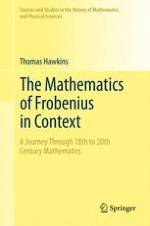2013 | OriginalPaper | Chapter
14. Alternative Routes to Representation Theory
Author : Thomas Hawkins
Published in: The Mathematics of Frobenius in Context
Publisher: Springer New York
Activate our intelligent search to find suitable subject content or patents.
Select sections of text to find matching patents with Artificial Intelligence. powered by
Select sections of text to find additional relevant content using AI-assisted search. powered by
